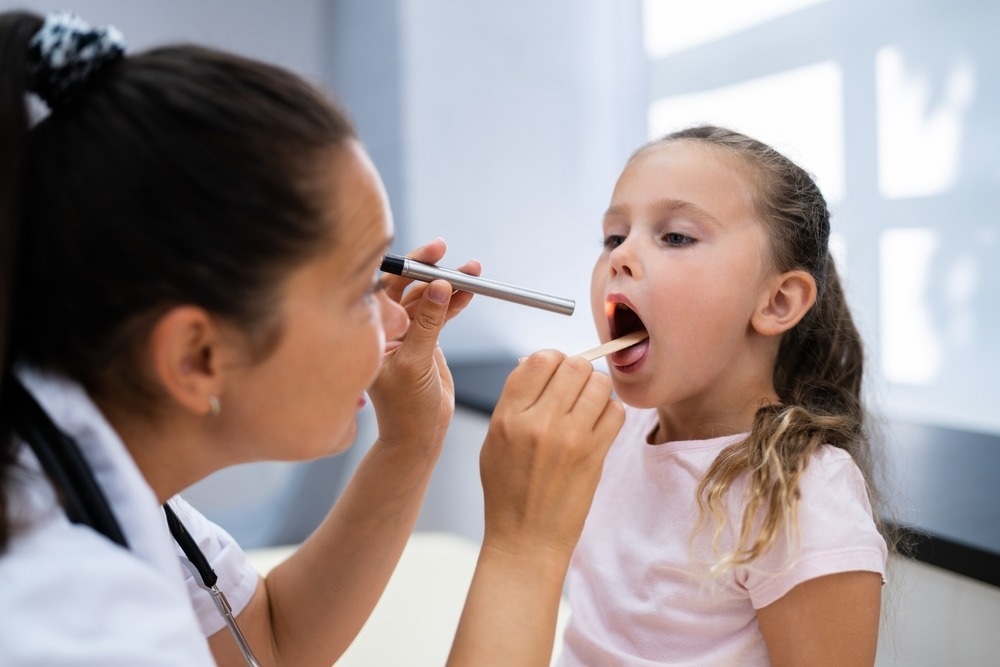The severe acute respiratory syndrome coronavirus-2 (SARS-CoV-2), the causal agent of the ongoing coronavirus disease 2019 (COVID-19) pandemic, causes respiratory infection in people of all ages.
Compared to adults, children are less frequently and severely affected by SARS-CoV-2. Although the exact reason for this is unclear, reduced expression of the angiotensin-converting enzyme 2 (ACE2) receptor and transmembrane protease serine 2 (TMPRSS2) in children’s respiratory tract could be a contributing factor.
Study: Tonsils are major sites of prolonged SARS-CoV-2 infection in children. Image Credit: Andrey_Popov / Shutterstock.com
Background
Previous research has highlighted the presence of significant respiratory viruses, including endemic coronaviruses, in the tonsils and adenoids of patients suffering from chronic tonsillar diseases. However, at the time of the analysis, these patients did not experience any recent symptomatic airway infections.
Furthermore, tonsils have been reported as sites of asymptomatic respiratory virus infections. Considering these findings, a recent study published on the medRxiv* preprint server evaluated the presence of SARS-CoV-2 in children’s tonsils during the COVID-19 pandemic.
About the study
The current cross-sectional study was conducted between October 2020 and September 2021 at the University of São Paulo. Children between the ages of three and 11 with recurrent tonsillitis or obstructive sleep apnea who underwent adenoidectomy or tonsillectomy were included in the study.
During the time of this investigation, none of the children in Brazil had been vaccinated against COVID-19. Children with craniofacial malformations, immunodeficiencies, deposit diseases, suspected tonsillar cancer, and genetic syndromes were excluded from the study.
The clinicians obtained several samples, such as bilateral nasal wash, bilateral cytobrush of the olfactory area, peripheral blood for serological tests, and adenoid and palatine tonsil tissues, during the surgery of the participants.
Study findings
A total of 48 children (30 boys and 18 girls) were enrolled in this study, 57.2% of whom were Caucasian. The mean age of the participants was 5.9 years.
About 50% of the patients had no associated diseases; however, the other 50% of the cohort were previously diagnosed with allergic rhinitis, recurrent otitis media, or mild asthma.
The parents of the patients stated that none of their children were treated with antibiotics for an average of 9.2 months before their surgery.
About 17% of the cohort was exposed to SARS-CoV-2 in their households forty days to six months before surgery. Furthermore, two patients confirmed a prior SARS-CoV-2 infection, while one patient lost their sense of smell and taste one month before surgery but tested negative for COVID-19 through the polymerase chain reaction (PCR) assay. According to the parents/guardians, the last acute upper airway infection requiring antibiotics occurred 1 to 24 (average 9.2) months before surgery.
SARS-CoV-2 was identified in the upper respiratory tract samples from 25% of the cohort subjected to tonsillectomy, all of whom did not report a recent history of COVID-19. The authors failed to determine the time of initial COVID-19 exposure.
SARS-CoV-2 genetic material was detected using quantitative reverse transcription PCR (qRT-PCR) in three samples from children with confirmed COVID-19. Since viral burden varied significantly from hundreds to thousands of copies per microgram of ribonucleic acid (RNA), the authors presumed that participants underwent a tonsillectomy at different times post-infection.
However, the time of COVID-19 exposure remained unknown, and most children were asymptomatic. The lack of this information prevented the authors from establishing an association between infection duration and viral loads at the time of the tonsillectomy.
Serological analysis revealed that five out of twelve children were immunoglobulin G (IgG)-positive; however, none were IgM-positive for COVID-19.
The presence of structural viral proteins was detected in the palatine tonsils and adenoids, particularly in the lymphomononuclear and epithelial cells of different lymphoid compartments. Interestingly, two children who had SARS-CoV-2 detected in their tonsils also exhibited the presence of SARS-CoV-2 protein in cells from the olfactory region.
Through flow cytometry analysis, the SARS-CoV-2 antigen was identified in the key types of tonsillar mononuclear cells (TMNCs), including dendritic cells, macrophages, and B and T lymphocytes. Since SARS-CoV-2 was detected in these cells and given that infection of monocytes triggers inflammasomes, the authors presumed that SARS-CoV-2-infected cells in the tonsils would enhance inflammation in previously chronically inflamed tissue.
Generally, ACE2 and TMPRSS2 proteins are highly expressed in the upper respiratory tract. The current study revealed higher expressions of these proteins in SARS-CoV-2-infected tonsils, thus suggesting that COVID-19 tonsillar infection supports enhancement of ACE2 and TMPRSS2 expression.
Conclusions
Tonsils and olfactory epithelium could be sources of viral shedding in nasal washes of COVID-19 asymptomatic children, which likely allowed these children to promote viral transmission in the community. In addition to epithelial cells, all major types of lymphomononuclear cells were found to host SARS-CoV-2.
Taken together, the present study revealed the presence of SARS-CoV-2 RNA and proteins in nasal cytobrushes, tonsils, and respiratory secretions from children with tonsillar hypertrophy, without manifesting any COVID-19 symptoms.
*Important notice
medRxiv publishes preliminary scientific reports that are not peer-reviewed and, therefore, should not be regarded as conclusive, guide clinical practice/health-related behavior, or treated as established information.
